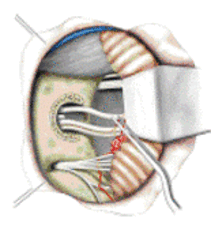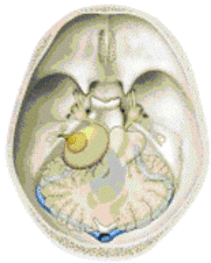Cerebellopontine angle surgery
Cerebellopontine angle and posterior cranial fossaWhat does a lesion in the cerebellopontine angle or in the posterior fossa mean?
Dizziness and hearing impairment are sometimes the first signs of a lesion located in the area between the brain stem and cerebellum (cerebellopontine angle). As a result, facial pain, paralysis of facial muscles, diplopia (double vision), dysphagia (swallowing disorder) or hoarseness may occur.
Due to magnetic resonance imaging (MRI) and computer tomography (CT), and because of their specific symptoms these tumors, which account for about 8% of all tumors in the skull, nowadays rarely remain undetected for a long time.
This is due to the anatomically distinctive feature of this region: In a confined space the central parts of 10 of the 12 cranial nerves are located (see Figure 1).

Figure 1: View into the left cerebellopontine angle after removal of an acoustic neurinoma. Right below the spatula the cerebellum can be seen. The stimulation forceps are at the facial nerve. Above one can see onto the fourth and fifth cranial nerve and the cerebellar tentorium, underneath onto the auditory nerve and the group of swallowing nerves. On the left side the petrous bone with the inner ear marks the lateral boundary of the cerebellopontine angle.
Image by courtesy of Prof. S. Rosahl, Erfurt
The symptoms therefore correspond frequently with malfunctions of the affected nerves:
- Hearing loss
- Ringing in the ears (tinnitus)
- Dizziness and unsteadiness
- Pain and numbness in the face or outer ear
- Double vision
- Dysphagia
- Hoarseness
- Weakness of facial-, head- and shoulder muscles
The most common disorders that occur due to pounding pressure of blood vessels onto the cranial nerves (microvascular compression) are trigeminal neuralgia (fifth cranial nerve) and hemifacial spasm ("facial tic", 7th cranial nerve). But also dizziness, tinnitus, torticollis and high blood pressure may arise.
The most common tumor in the cerebellopontine angle is the acoustic neurinoma (vestibular schwannoma) (see Figure 2), that can occur rarely bilaterally in the context of a genetic disease, such as neurofibromatosis.

Figure 2: acoustic neurinoma (vestibular schwannoma) in different stages. The tumors almost always reach into the internal auditory canal, where auditory nerve, facial nerve and vestibular nerve run close together, whereas larger tumors may even displace the brain stem significantly.
Image by courtesy of Prof. S. Rosahl, Erfurt
Larger tumors can also block the channel system for cerebrospinal fluid drainage (ventricular system) and this can cause a congestion of cerebrospinal fluid (hydrocephalus). With the displacement of the brain stem and obstruction of the cerebrospinal fluid system symptoms may develop such as nausea, gait instability, coordination disorder, headache, extreme fatigue and sometimes paralysis of the muscles.
Without treatment permanent functional loss up to irreversible damage of the vitally important centers in the brain stem may occur.
What are the treatment options?
Due to the different nature of lesions there are several possibilities. Often, there is no immediate time pressure for the treatment of slow-growing tumors and follow-up examinations can be scheduled. Sometimes decongestant or growth-inhibiting drugs are being adiminstered. Embolization (interventional vascular treatment method using catheters) is suitable for the treatment of vascular processes. In some tumors radiation therapy and radiosurgery are employed very successfully.
In general, surgery is performed with the aim to completely remove the focus of disease. This applies particularly when other treatments are less effective, may cause severe side effects or the diagnosis is in doubt. The purpose of surgery is to remove the cause of the existing and to prevent or delay the appearance of new symptoms. Often different treatment modalities are combined.
The choice of surgical method depends on the nature and location of the lesion. The surgical approach should be as minimal as possible. Particularly suitable are microsurgical and endoscopical techniques which are sometimes used in combination. Intraoperative navigation supports the exact surgical planning. Using a microscope, the surgeon can optimally visualize the disease process. With special micro-instruments, ultrasonic aspirator, bipolar coagulation, laser and special suction cannulas, tumors can be removed (see Figure 3).

Figure 3: Removal of a tumor (vestibular schwannoma) in the cerebellopontine angle using an ultrasound aspirator.
Image by courtesy of Prof. S. Rosahl, Erfurt
Conflicts between the cranial nerves and blood vessels (microvascular compression) can be eliminated by relocating the irritating vessel from the nerve and inserting Teflon®-wool or a muscle patch as cushion between them to prevent new contact.
Vascular malformations are being eliminated with titanium clips or wrapped with various materials.
During surgery in the cerebellopontine angle, the function of the nerves and brain stem is kept under surveillance by an intraoperative monitoring system using electrodes (see Figure 4).

Figure 4: Neurophysiological monitoring of the function of the auditory nerve, facial nerve and brain stem during surgery under general anesthesia.
Image by courtesy of Prof. S. Rosahl, Erfurt